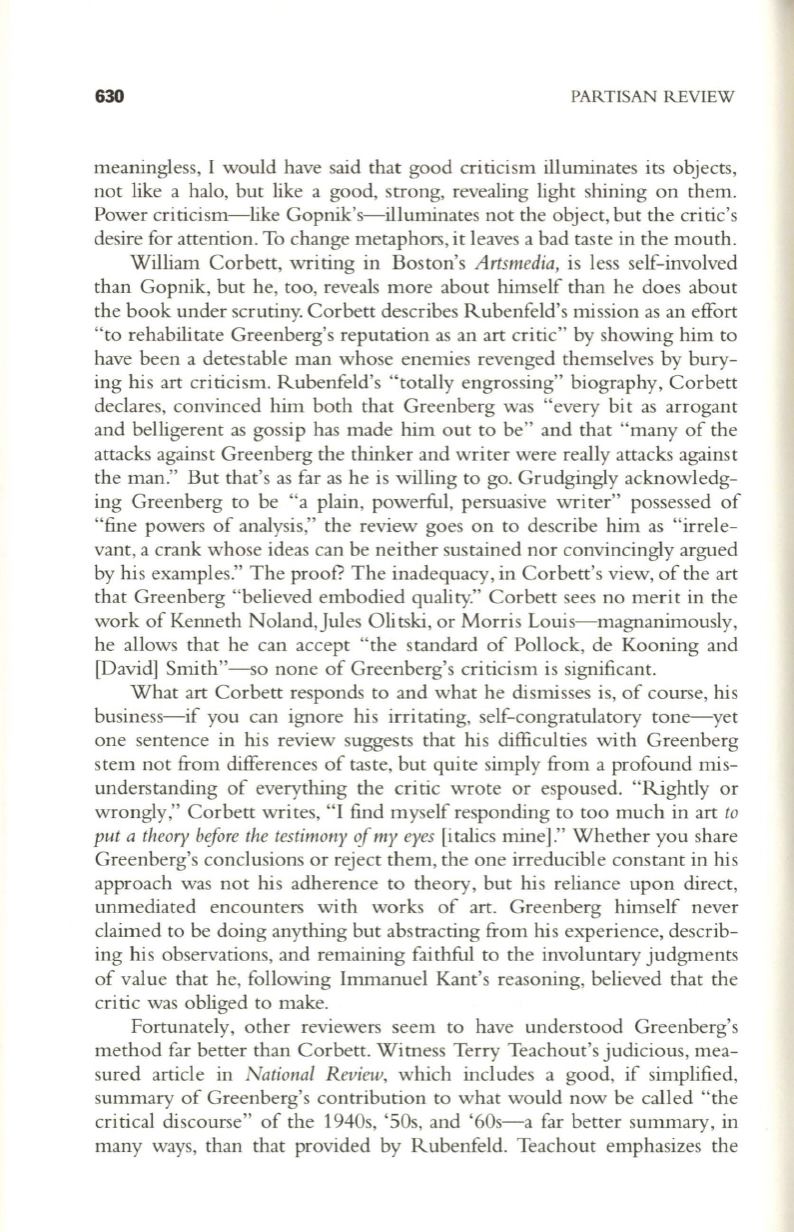
630
PARTISAN REVIEW
meaningless, I would have said that good criticism illuminates its objects,
not like a halo, but like a good, strong, revealing light shining on them.
Power criticism-like Gopnik's-illuminates not the object, but the critic's
desire for attention. To change metaphors, it leaves a bad taste in the mouth.
William Corbett, writing in Boston's
Artsmedia,
is less self-involved
than Gopnik, but he, too, reveals more about himself than he does about
the book under scrutiny. Corbett describes Rubenfeld's mission as an effort
"to rehabilitate Greenberg's reputation as an art critic" by showing him to
have been a detestable man whose enemies revenged themselves by bury–
ing his art criticism. Rubenfeld's "totally engrossing" biography, Corbett
declares, convinced him both that Greenberg was "every bi t as arrogant
and belligerent as gossip has made him out to be" and that "many of the
attacks against Greenberg the thinker and writer were really attacks against
the man." But that's as far as he is willing to go. Grudgingly acknowledg–
ing Greenberg to be "a plain, powerful, persuasive writer" possessed of
"fine powers of analysis," the review goes on to describe him as "irrele–
vant, a crank whose ideas can be neither sustained nor convincingly argued
by his examples." The proof? The inadequacy, in Corbett's view, of the art
that Greenberg "believed embodied quality." Corbett sees no merit in the
work of Kenneth Noland,Jules Olitski, or Morris Louis-magnanimously,
he allows that he can accept "the standard of Pollock, de Kooning and
[David] Smith"-so none of Greenberg's criticism is significant.
What art Corbett responds to and what he dismisses is, of course, his
business-if you can ignore his irritating, self-congratulatory tone-yet
one sentence in his review suggests that his difficulties with Greenberg
stem not from differences of taste, but quite simply from a profound mis–
understanding of everything the critic wrote or espoused. "Rightly or
wrongly," Corbett writes, "I find myself responding to too much in art
to
put a theory bifore the testimony of my eyes
[i talics lnlne]." Whether you share
Greenberg's conclusions or reject them, the one irreducible constant in his
approach was not his adherence to theory, but his reliance upon direct,
unmediated encounters with works of art. Greenberg himself never
claimed to be doing anything but abstracting from his experience, describ–
ing his observations, and remaining faithful to the involuntary judgments
of value that he, following Immanuel Kant's reasoning, believed that the
critic was obliged to make.
Fortunately, other reviewers seem to have understood Greenberg's
method far better than Corbett. Witness Terry Teachout's judicious, mea–
sured article in
National R eview,
which includes a good, if simplified,
summary of Greenberg's contribution to what would now be called "the
critical discourse" of the 1940s, '50s, and '60s-a far better summary, in
many ways, than that provided by Rubenfeld. Teachout emphasizes the


